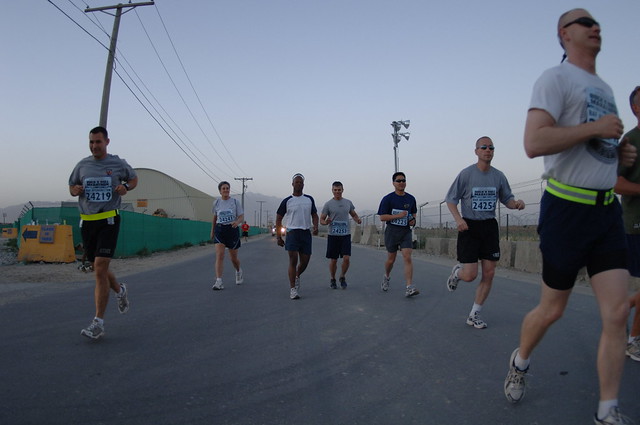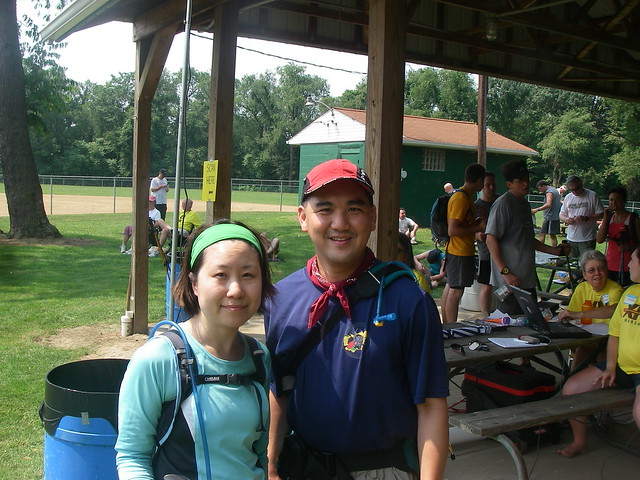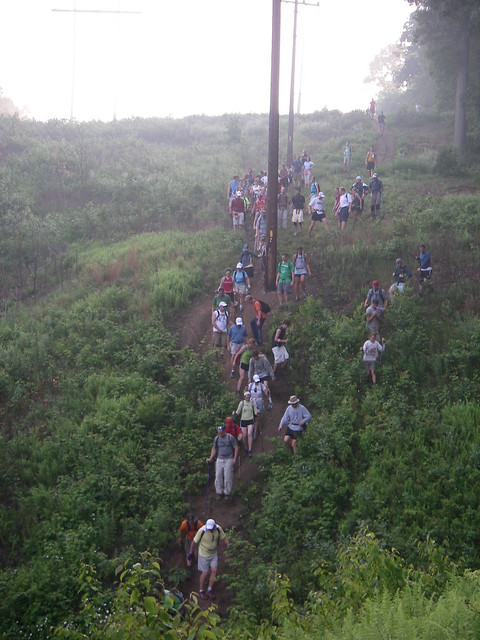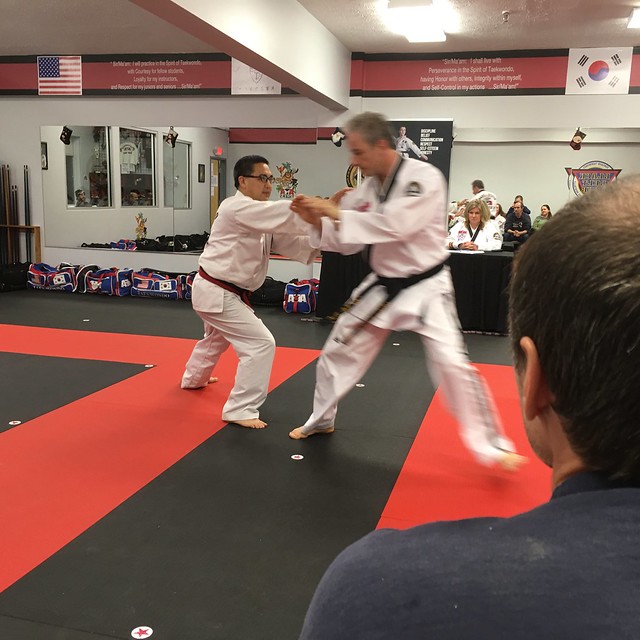I started running recreationally in college. After college I lived in the Washington DC area, and I started running consistently. Over my DC years, I built up my running to the point that 5K and 10K runs were nothing special. I was not very fast, but I could put up miles.
 |
| Chicago Marathon support crew |
 |
| Rock and Roll Marathon - Bagram Air Base (Afghanistan) |
 |
| Rachel Carson Challenge |
 |
| Hills on the Rachel Carson Challeng |
 |
| Self-defense technique testing at ATA TKD |
When I got home, I realized that I was at a point that getting some instruction would be useful so I bought a set of 5 personal trainer sessions at the YMCA. While I did achieve my goal of improving form on deadlifts, squats, and bench presses, I realized that what I really got out of it was a range of other workouts. Also I realized that I really was not interested in the machines (they had only one power rack, two benches, and one smith machine as well as one deadlift platform, so not all that much room for free weights compared to the rows of machines). Third, I also realized that I wanted my non-TKD workouts to provide both strength and conditioning. And while I was good at pushing strength (I had been on the linear curve for 8 months by then), good conditioning workouts require outside intervention. And, while I liked my trainer, $40 per session (and that is factoring in the free intro) was more than I wanted to pay, because at some point, he was more of a programmer and cheerleader than an instructor.
So, what did I want? I was looking for programming, that provided strength and conditioning, that was reasonably fast (1/2~1 hour in a session), and I could do at home (mats on floor for bodyweight, dumbbells, suspension straps, medicine ball, punching bags.) And I had no intention of buying a barbell and rack (because then I would have to figure out where to put them)
Given that my goal was strength and conditioning, I started looking at CrossFit. A CrossFit gym membership was looking expensive, especially considering this would be my second fitness cost (I am continuing TKD). So I was looking at the online only programs. Problem I found here is that most online programs were aimed at people who were competitive, e.g. who had a goal of doing well in competitive fitness such as the CrossFit Open (and highlighted their athletes who qualified for regional and national level competitions.) Strength based training all had as a starting point a barbell and a powerrack as basic equipment (actually, they all had an attitude that being able to work with a barbell and power rack counted as minimalism) StreetParking stood out in that they scaled (had variations of workouts using either lower weight or easier movements for people who could not do the prescribed workout) and they guaranteed that one of the three main variations on the WOD would be for people who only had dumbbells and a jump rope, which was a unique variation on minimalism that counted me in.
In August I started doing a few sample workouts they had posted on their YouTube channel, as well as some workouts being done by other people who were posting sample workouts as reviews on the programming. These were hard, but I could do them with scaling. And I was pretty wiped out when I was done. This was a good combination of characteristics, so I signed up.
What is CrossFit? The definition comes from Greg Glassman, the founder:
CrossFit is constantly varied functional movements performed at high intensity.
- Constantly varied means that workouts will change daily, with many variations on exercises to ensure that all muscles get targeted over any reasonable period of time. More notes to follow
- Functional movements means that workouts would be in a manner similar to that experienced in the real world. This means multiple muscle groups and multiple planes of motion. This contrasts with isolation exercises (single muscle) and exercise machines (which are all designed to focus on one plane or axis of motion per machine)
- High intensity means that the workouts are designed to increase power, which is Force * Distance/time. So this means maximizing the combination of weight and distance traveled over the course of a period of time. This is in contrast to focusing only on force (i.e. powerlifting) or only on distance (which is what endurance or cardio workouts do)
In their definition of fitness, CrossFit recognizes that there are 10 broad areas of fitness: What is Fitness?. They are cardiovascular/respiratory endurance, stamina, strength, flexibility, power, speed, coordination, agility, balance and accuracy. And the exercises they use to get there are taken from gymnastics, power and olympic lifting, and endurance sports.
One thing that CrossFit shares with its other weightlifting cousins (powerlifting, bodybuilding, olympic lifting) is the need to collect data on progress. This is more difficult for CrossFit because of the large number of different workouts. But there are a number of benchmark workouts, known as The girls (because they are all given girls names) that serve as touchstones. And every CrossFit program will include them periodically to give their members personal benchmarks of progress over time, and to allow comparisons across programs.
In the week (seven days) of my official CrossFit journey (not counting the sample workouts I tried out), I went going to a fundraising event (22 too many by Active Heroes) at a local CrossFit gym on Sunday, where they essentially did a hero Workout of the Day (WOD). I did 4 of 5 workouts at Street Parking. Then for my birthday I did a Hero WOD (Saman). In CrossFit, Hero WOD are named after those who die in service (i.e. military or first responders). One way I have read it described was that a Hero WOD is supposed to remind you of a young man at the peak of their physical prowess, who died in action. So these are much harder than the norm. Often, it is a favored workout of that hero. Other times it is designed symbolically (the Saman workout is one of these). But it is not designed for the average person to be able to complete.
Some thoughts:
- I definitely get the constantly varied part. So far, I have been keeping my weights down because every workout has at least one movement that I have not yet gotten into a good rhythm.
- There is still strength training. I have seen deadlifts, squats, thrusters (variation on presses), cleans, and snatches. No bench presses, but that is the only one of the standard powerlifting and olympic lifting moves that I have not seen in only one week. And I am nowhere near the prescribed weights for any of them (My best deadlift is 150, squat is 135, bench press is 125 using bars) so I have a long way to go. There are also a mix of reps, sometimes low (4-6), sometimes the high reps that CrossFit is infamous for, but those high rep exercises are also prescribed to lower weights.
- I believe in scaling. Scaling in CrossFit is the practice of doing an exercise at a lower weight so that you can do it correctly over the reps given. Alternatively, if an exercise is beyond the skill/strength of the athlete, alternative exercises that target the same muscles and motions can be substituted, presumably keeping the athlete on the path towards achieving the correct exercise someday. This should still make the last set very difficult.
- I still get endurance. There was a 22 Cal row at the CrossFit gym. The workouts I have done also have included 3 medium distance runs. (1 mile, 400m, 3.2km). Strength plus cardio in a single workout becomes incredibly efficient use of workout time.
- For conditioning, I am consistently worn out by the end of the workout. More workouts than not include a time where my shirt is off and I am on my back. Funny story. I lay down in the middle of the 22toomany workout (after exercise #18 or so out of 22, and my 4 year old comes next to me and shakes me saying "exercise, exercise"
- I have done my first benchmark WOD (Fran, but embedded in another workout), and my first hero WOD (Saman)
No comments:
Post a Comment